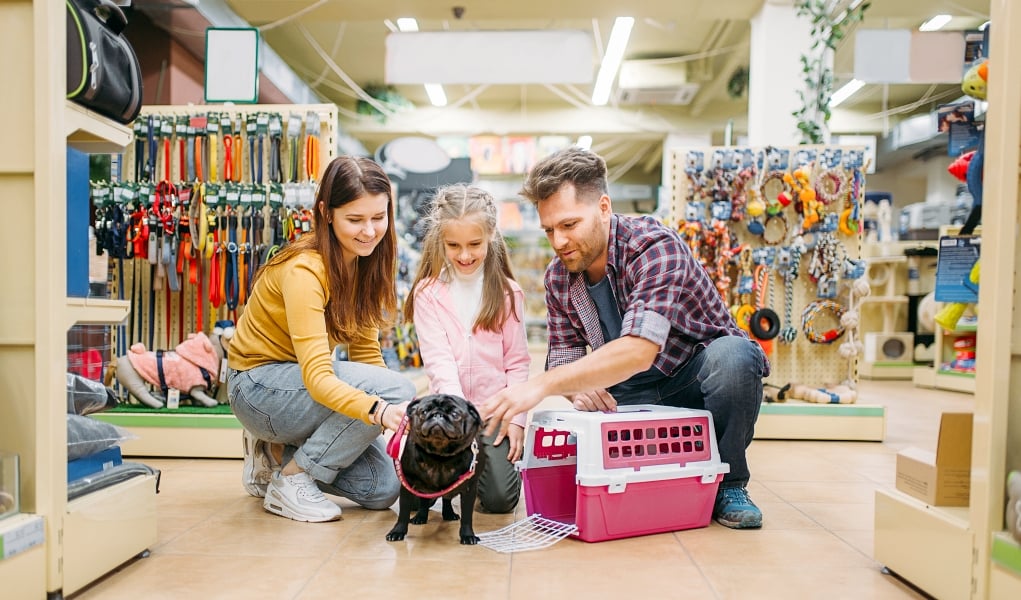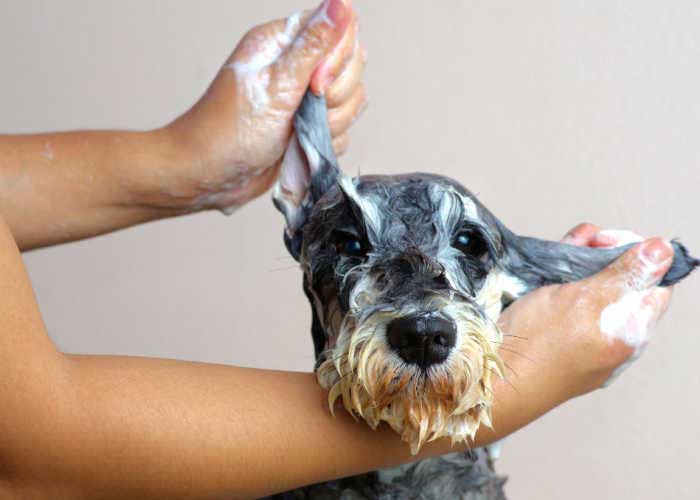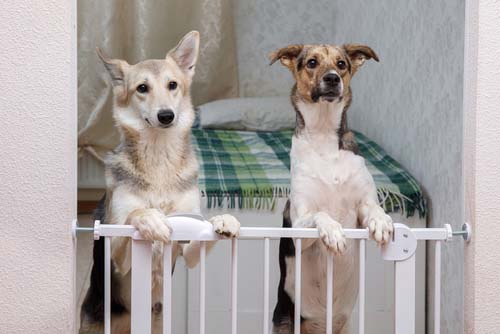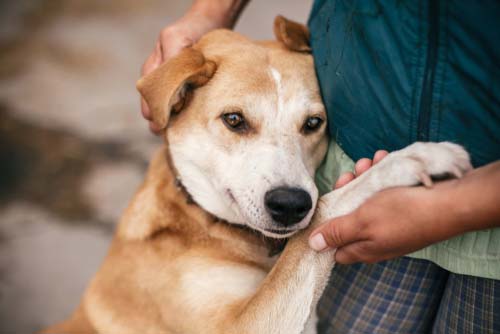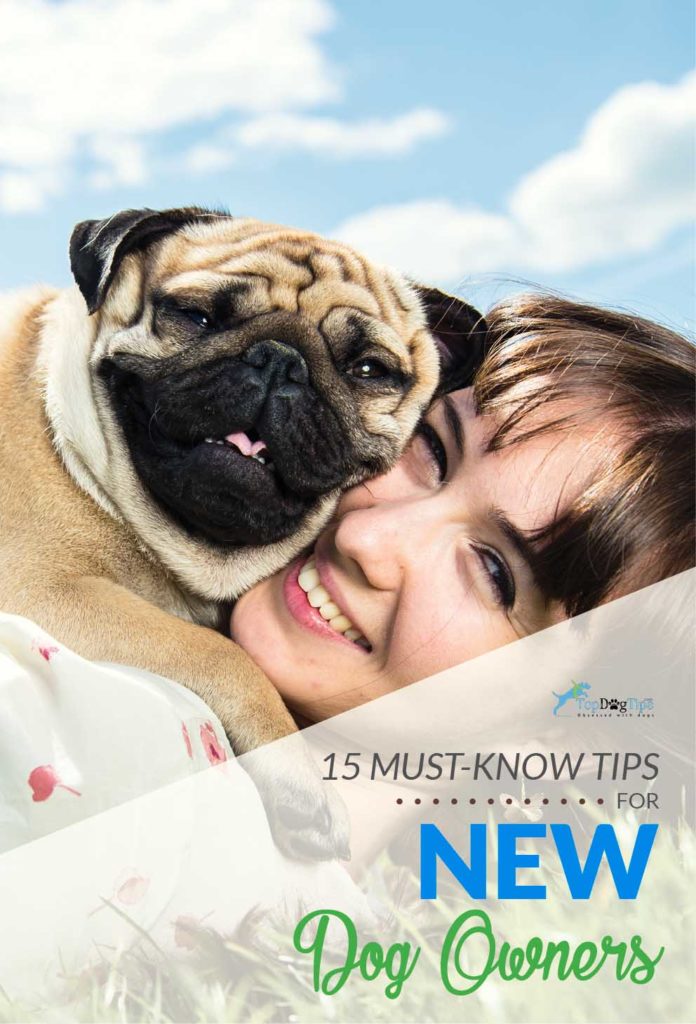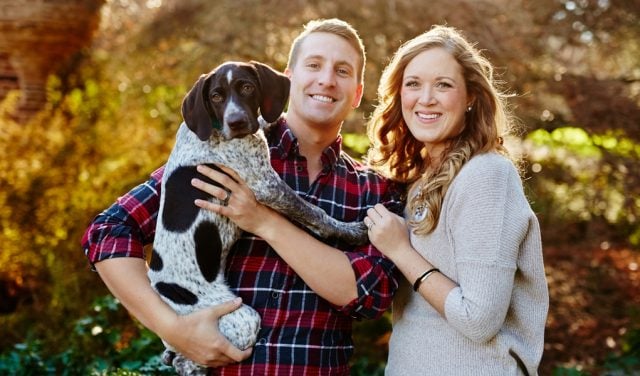
Table of Contents
- But First, Before You Adopt a Pup…
- 15 Tips for New Dog Owners
- Tip #1: Do a Background Check
- Tip #2: Keep Your Records Handy
- Tip #3: Book a Vet Check-up
- Tip #4: Get the Right Dog Supplies
- Tip #5: Choose the Right Dog Food
- Tip #6: Give your Dog Space
- Tip #7: Pick the Right Dog Grooming Items
- Tip #8: Help Your Dog Adjust to Seasonal Changes
- Tip #9: Know Animal Laws and Bylaws
- Tip #10: Training is a Must
- Tip #11: Set a Regular Routine with Specific Times
- Tip #12: Set Up Your Home for Success
- Tip #13: Start with Sensible Expectations and Rules
- Tip #14: Enroll Your Dog in Obedience School
- Tip #15: Know When You Could Use Some Help
- Tips for New Dog Owners: Before You Go…
I‘ve been a dog owner for over 20 years and have adopted and rescued many, many dogs in the past.
And let me tell you straight away: owning a dog is an exciting adventure that comes with a big responsibility.
If you are an aspiring dog owner who has decided to adopt from a shelter, good for you!
Just make sure you're prepared for this new adventure that you're jumping into by following these tips for new dog owners.
But First, Before You Adopt a Pup…
Your planning should begin months before you bring your new pet home.
Remember: You're about to be responsible for the feeding and daily care of another living being.
It's something that you should not take lightly because many other pet owners sadly already do.
But figuring out how best to care for a new dog is not the first step.
Before you do anything else, be sure that you choose the right dog. Ask yourself these questions:
- What breed of dog will best suit your lifestyle?
- Will a small or large breed be the best fit for your home and situation?
- Do you want an active dog or a snuggle bug that will lie with you on the couch?
Such questions are just the tip of the iceberg when it comes to choosing the best dog.
You could take an online quiz, talk to other pet owners, research the best and worst breeds for first-time owners online, and read books on the subject.
Once you've chosen a breed you think will fit nicely in your home, it's time to prepare for your new pet.
Figure out what responsibilities will be involved in your new dog care and who will perform each task, especially if you're adopting as a couple.
Discuss the new addition with your entire family and ensure everyone understands what is involved in caring for dogs.
Consider researching the most important aspects of pet care.
Literature on dog training, the basics of grooming, and key dog health/care will be extremely helpful to first-time dog owners.
If you're sure you're ready to take on the responsibility of a dog, the tips will make things a little easier for you and your new pup.
15 Tips for New Dog Owners
Tip #1: Do a Background Check
It's important for new dog owners to find a breed that will fit with their lifestyle and environment.
Research your dog's breed or the breeds in their family background first.
This will give you a big picture of their specific needs and temperament.
Ask the breeder or the rescue staff about the dog's medical history, and get as much documentation as possible.
Spending time with your dog's family, both the canine and the two-legged variety, can give you some idea of what you might expect regarding behavior.
Of course, this isn't always possible.
If you're really curious or don't have access to your dog's previous owners, you can purchase a dog DNA testing kit that can give you information on your dog's breed and any genetic conditions she may have.
ALSO READ: What Breed Is My Dog? Here are 4 Easy Ways to Find Out
If you do have the opportunity to speak with your dog's previous owners, these are some questions you might want to ask:
- Have they or their parents had any health problems?
- How old is the dog?
- What kind of temperament do they have?
- How much activity are they used to, and how much do they need?
- What kind of training have they had?
- What kind of discipline techniques work?
- Has the dog had experience with other animals or children?
- How much time does she spend inside or outside?
- What kind of food has she been eating, and how much?
- Does she have any special likes or dislikes?
- Has the dog been spayed or neutered?
- Has she been treated for parasites, and when?
- Is the dog up to date on her shots?
Tip #2: Keep Your Records Handy
If your dog is from a shelter, you might not know much about her background.
Get what you can now that she's found her forever home.
You'll need to keep track of certain things from now on, including:
- When you got her, and how old she was
- Trips to the vet, health problems, vaccinations, and medications
- Behavior in different situations, like at the groomer or a kennel
This information should be kept to make it easy to share with your vet or anyone else who might spend time with your dog, like a house-sitter.
Keeping it on your phone is easier, so you'll always have it with you.
Tip #3: Book a Vet Check-up
Don't wait for a problem to find a veterinarian.
You don't want to do it when you're pressed for time, and you might not want to go with the first one in the phone book or whoever's closest.
You'll share any history or information that you have about the dog, and your vet will do a full examination.
They will possibly take blood for the heartworm tests. What happens next is dependent on whether you have records for him.
If you've adopted a young dog, puppy shots may be required.
One good thing about getting a dog from a shelter is that they are generally up-to-date with all their shots and tests.
You should get copies of this information when you go home.
Some more things to discuss during your first veterinarian visit include:
- spaying/neutering (if necessary)
- flea and tick prevention
- blood work to check for health issues (if needed)
- appropriate diet
And while you're at it, why not ask the vet all your questions and concerns about being a new dog owner? I'm sure they'll have plenty to share that'll help you big time.
Tip #4: Get the Right Dog Supplies
Research what you really need for your dog based on age, breed, and activity level.
There are millions of products on the market, and a lot of people out there are happy to sell you something, so make your purchasing decisions wisely.
My suggestion? Start with the basics!
Your dog will need:
- a leash
- a collar and harness
- a few toys, especially for chewing
- bowls for food and water
- puppy pads for accidents or indoor training
- food and treats
- grooming items
- a place to sleep
- a safe place to get outdoor exercise
Tip #5: Choose the Right Dog Food
Your dog's diet should fit her age, breed, size, health conditions, and activity level.
With various selections in the market, I know finding high-quality food can be a real challenge.
In fact, more than half of all dog owners find their dog's nutritional needs more confusing than their own, according to a survey by Purina.
It's important to know your dog's diet before you adopt him.
Ask his previous owner, breeder, or shelter operator about the brand and type of diet that your dog has been eating. Then, consult your veterinarian if you'd like to switch to a new food.
Depending on their evaluation, the vet will help you decide which dog food diet will offer your pet the best nutrition.
They can guide you in choosing the best brand and suggest feeding schedules, serving sizes, and how best to transition your dog to a new diet.
One tip to remember is that you should not continually change foods, as this will train your dog to be a picky eater.
An adult dog is best fed twice, morning and night, to avoid bloating, especially in a large-breed dog. You can get suggestions from your vet or fellow dog-owner friends.
Another thing to remember and educate yourself: Read dog food labels diligently and carefully.
Just because it says natural or grain-free on the label doesn't mean it's healthy.
It could still be full of peas, lentils, and chickpeas, which aren't any better.
READ: How to Read Dog Food Labels Accurately
Another option some dog owners go for is the raw food diet. However, I think this option is safer in the hands of a more experienced pet owner than a first-timer.
When mishandled, a raw food diet can be a health hazard for both pet and human owners because of possible contamination and the spread of bacteria from uncooked meat around the home.
Preparing a homemade diet isn't easy either, and inexperienced new dog owners may actually leave their pets with nutritional deficiencies by cooking the wrong recipes.
The wrong ingredients can also make your dog sick.
Ask your vet for advice, or better yet, seek the guidance of a canine nutritionist.
If you opt for commercial kibbles or canned food, research the brands you're considering. Be sure to find out:
- how it's made
- where it's made
- what ingredients are used, and where they are sourced
- how much is appropriate for your dog's breed, size, age, and level of activity
Tip #6: Give your Dog Space
Another important thing you must prepare is a safe space for Fido.
Some owner may be okay with letting their dogs sleep on the bed, while others do not.
In any case, it's best to get them their own doggy bed in a quiet corner of your house or bedroom.
He will sleep better if he has his own space, and he will begin to see his bed as an oasis where he can rest.
Dog beds also provide much-needed support for your pup's bones and joints. They are much better for your dog's health than a blanket on the floor.
Oh, and don't forget the crate.
Crate training is highly recommended by professional dog trainers, veterinarians, and other experts in the pet industry.
It might look like a cage, but a good metal or soft dog crate is a den for your dog.
It can be used for training and to prevent behavior problems, but it should never be used as a punishment.
If you use it too much or the wrong way, your dog might be afraid of his crate.
The crate should be large enough for your dog to stand up and turn around at her adult size but not so large that she can go to the bathroom at one end and sleep at the other.
If she's still a puppy and you bought a large one for when he gets bigger, you can block a part off.
Crates are also a good idea if you want to travel. They could be a safe, familiar way to transport your dog in a car or other vehicle.
One golden rule when crate-training: Do not leave your dog in the crate for too long.
Puppies under six months, or dogs who aren't house trained, shouldn't be crated for more than three or four hours.
If the dog seems depressed, anxious, or hyper, she might need more exercise or attention.
You may need to look into a pet sitter or doggy daycare.
For more information on the benefits of crate training, check out these resources:
- Puppy Crate Training Schedule
- 16 Tips for Crate Training A Dog
- 20 Tips for Crate Training A Puppy
- 5 Mistakes of Crate Training Dogs (and how to fix them)
Tip #7: Pick the Right Dog Grooming Items
How often you groom a dog usually depends on their breed.
Are they a shedder? Do they have long or short fur? Any folded skin? Allergies or sensitivities?
You would want to have the appropriate grooming tools for your dog's different features, like getting the right hair brush, nail clippers/grinders, shampoo, conditioner, wipes, etc.
But whatever your dog's size and breed is, one important thing to note is they will need their teeth brushed daily.
So, yes, you'll need a toothbrush and get your dog to use it.
As much as you might wish there was a shortcut, plaque sprays, dental water additives, and chew treats aren't adequate replacements.
If you don't even know how to start brushing your dog's teeth, ask for your veterinarian's help.
Some tasks can be outsourced to a professional groomer, which might make nail clipping, washing, shaving, and trimming easier.
They have the tools and expertise that most dog owners lack, especially if this is your first dog.
Tip #8: Help Your Dog Adjust to Seasonal Changes
Most are unaware of this, so it's best to start you, the new dog owner, to a good start by learning that our dog's needs change as seasons change.
For example, short-haired or smaller dogs need help to deal with the cold during winter.
Some new dog owners may think that dog sweaters are only cute fashion items, but they can actually help Fido stay warm and snug.
Other apparel items, like dog jackets and boots, may also be necessary if you live in a colder climate.
On the other hand, some dogs are more at risk for overheating outside in the summer.
Dogs with double-coated fur, like Huskies, don't really sit well in the heat, and brachycephalic breeds, like Pugs, can have breathing issues, especially in high temperatures.
Owners of these breeds should always make sure that their pups are well-hydrated and have a dedicated spot where they can cool off.
You'll also need to consider the weather in your region when deciding whether or not to leave your pet outside for extended periods of time.
Based on the climate, you may need a well-insulated dog house, an outdoor kennel, or an awning for shade.
One of our editors, Samantha, has done a podcast with a veterinarian discussing how the needs of a dog change with seasons, particularly their nutritional requirements.
Tip #9: Know Animal Laws and Bylaws
There are several dog-related laws first-time owners should be aware of, be they specific to their neighborhood, city, or state.
Are you a homeowner or living in a rental apartment?
If you live in a neighborhood governed by a homeowner's association, several rules may need to be followed; they're slightly infamous for that.
For example, they may have rules about the type of fencing you can use to contain your dog in the yard or how much barking will be tolerated.
Some even have bans on specific breeds, too.
For rentals, you may need to ask your landlord's permission before bringing your new pet home.
Get all needed permissions in writing before bringing your pet home.
Also, some states require mandatory registration and certain dog vaccinations, especially for rabies. Both are generally required everywhere in the U.S.
You also might consider getting a pet license, microchipping, or registering your dog with a recovery service.
Due diligence is always rewarded when it comes to ensuring you can have your dog where you live.
Knowing the laws and bylaws that apply to dog owners in your area can save you a lot of trouble down the road.
Tip #10: Training is a Must
You can definitely ask your dog's previous owner if he has been trained, but you don't want to depend entirely on their honesty.
Skills are sometimes lost, too, when dogs are under stress or in a new environment.
It's better to assume that you and your dog must learn (or re-learn) house training rules together.
You can do this in two different ways:
- reward the dog for doing what you want
- prevent mistakes from happening by being proactive
Some owners believe that they should give a new dog a few days to adjust to their new environment before beginning training or starting a routine.
This is completely wrong.
You need to begin working with your dog as soon as you bring them home.
In fact, you should decide on the training method you want to use even before your new pet arrives and start with crucial tricks and commands first.
Remember: Dog training should be consistent from day one.
This way, your dog won't develop any bad habits and will understand that previous bad habits will not be tolerated in this new home.
New dog owners need to start basic obedience training, like learning to sit and stay, especially if the dog is just 8-10 weeks old.
For the best results, practice regularly…
- when you come home
- before eating
- before going outside
This will help the dog learn basic manners, like not begging or jumping up on people.
Teaching your pet to sit when you open the door can keep her from running outside unpredictably, too.
Behavior problems are the most common reason for re-homing or putting a dog down, but the problem often starts with the owner.
It's up to you to teach your dog how to behave and to reward her for doing what you want.
Taking 10–15 minutes every day to train your dog will make both of you happier in the long run.
Don't think of it as a chore. It can be quality time together!
Tip #11: Set a Regular Routine with Specific Times
Training goes hand in hand with schedule and routine.
And the most crucial schedule to establish – for your dog's well-being and your own sanity – is a nighttime routine.
Getting your dog to sleep through the night may be a challenge at first, especially with puppies, but once he's sleeping soundly, things will be much better for both of you.
Whether you crate train your dog, train him to sleep on his own bed, or allow him to sleep in bed with you, get a routine down.
Have your dog go to sleep around the same time each night, and get him up around the same time in the morning.
If your dog cannot hold his bladder/bowels all night, take him out for a potty break around the same time too.
Generally, you can expect your puppy to “hold it” for a number of hours equal to how many months old she is.
For older dogs, it's somewhere between 4 and 8 hours.
So, to teach them to hold it until a certain time, you'll want to make a habit of taking them out to pee at these times (at least):
- as soon as you get home
- after eating
- after naps
- before playing
- before bed
You should also schedule time for walking, playing, training, and just spending time together with every member of the family.
It will help with behavior issues, too.
A bored, isolated dog is only going to cause problems.
The most proactive thing you can do is ensure activity and social needs are met.
Tip #12: Set Up Your Home for Success
Dog-proofing your home is essential before or after adopting a new dog. It is the best way to keep your new pet safe and your house intact.
Indoor gates or fences are a good idea to keep them out of areas in your home you don't want them in.
Like small children, dogs learn about their environment by exploring, investigating, and testing everything around them.
They will use their paws and mouths to see how things work in their new home. Unfortunately, this can also get them into a lot of trouble and accidents.
Read more about how to puppy-proof your home.
Tip #13: Start with Sensible Expectations and Rules
Puppy-proofing your home should also involve setting expectations and rules for all family members.
If your family will be new dog owners, spend some time together learning about dog behavior, discipline, and training.
Decide with everyone in the house:
- what the rules for the dog are
- how to deal with bad behavior
- how to reward good behavior
- what kind of discipline will be used
- who is responsible for what, and when
Tip #14: Enroll Your Dog in Obedience School
New dog owners have no need to reinvent the wheel.
Signing your dog up for obedience class is probably the easiest way for you both to learn together, and it will give you the skills you need to cope with different situations.
It will also help to socialize your dog to be less afraid of strangers and other animals.
Obedience classes aren't just for puppies or young dogs either, and it's a fun thing to do together that helps build your bond.
Tip #15: Know When You Could Use Some Help
Raising a dog takes a village, and you're going to need one!
Before you bring your new dog home, you should set up a support system.
You'll need to research and find a veterinarian, dog groomer, pet sitter, trainer, and any other experts who may be able to help you in your journey as a new dog owner.
It's important to think about your needs and your dog's needs. This is where your research will come in handy.
For example, if you've adopted a breed known for having separation anxiety, you may want to hire a pet sitter.
If the shelter tells you that the dog you're adopting has behavior issues, you may want to have a trainer on standby after you bring your new pup home.
Tips for New Dog Owners: Before You Go…
Learning about your dog is a life-long adventure that doesn't end after the first few months.
No one likes to be taken for granted in a relationship, even dogs. Don't wait for problems to become ingrained.
Following these tips for new dog owners will make your dog care adventure much easier and more fun.
I've been a pet owner for more than 20 years and have a lot of experience with adopting new dogs.
These tips have definitely helped me, and I hope they can help you, too, jump-start your new life with a furry best friend by your side.
Related Articles:
- You've Adopted A Puppy. Now What?
- 6 Ways to Tell If You and Your Adopted Dog Are a Perfect Match
- Senior Dog Adoption: Should You Be Worried?
Want to share this?


